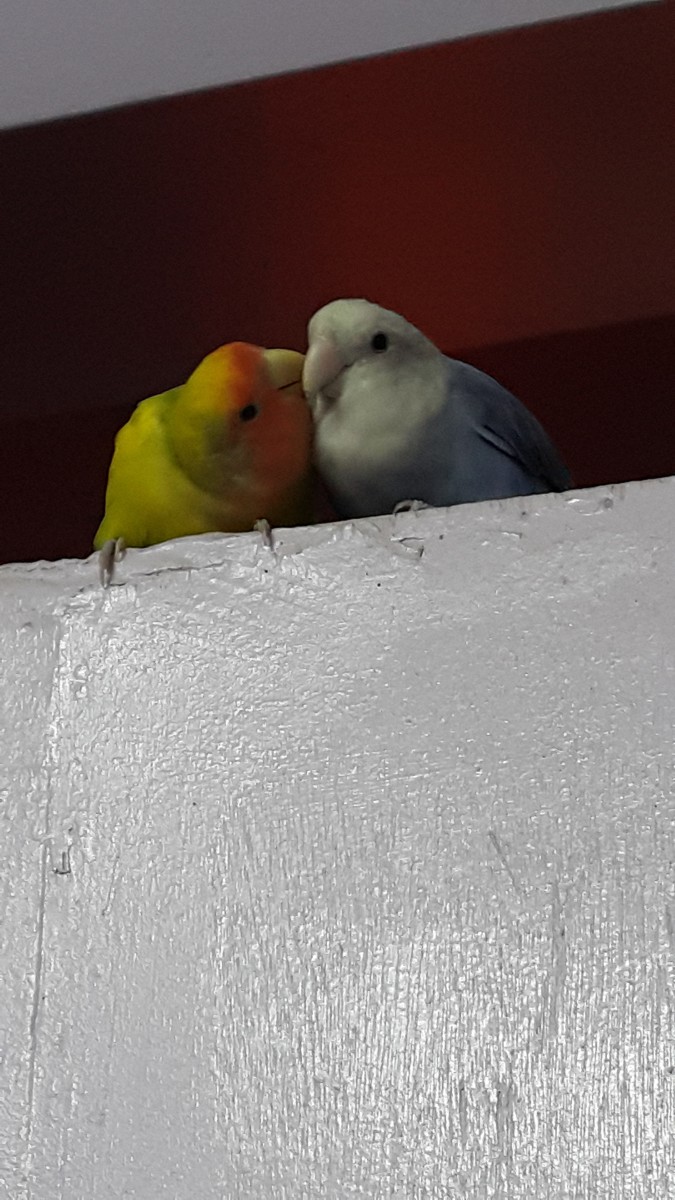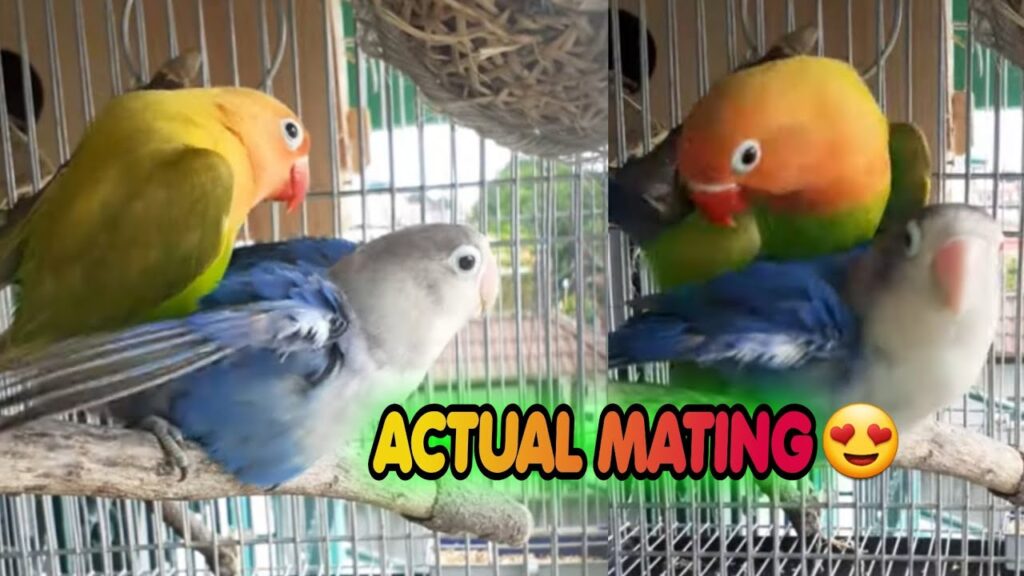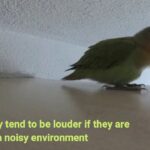Lovebirds mate through a courtship process followed by physical copulation. The male impresses the female with displays and feeding before mating.
Lovebirds, known for their strong pair bonds, engage in a fascinating mating ritual. This ritual is crucial for breeding as well as for maintaining their social connections. The male bird starts by performing a series of attention-grabbing antics, such as dancing and chirping, to win the female’s approval.
Partners may also be seen sitting close together, preening each other’s feathers, a sign of affection and bonding. The actual mating act is brief, with the male mounting the female to perform the cloacal kiss, which allows for the transfer of sperm. For those captivated by these vibrant birds, understanding their mating behavior offers insights into their complex social lives. It’s also a critical piece of knowledge for breeders and aviculturists who seek to ensure the health and continuity of lovebird populations.

Credit: pethelpful.com
The Mating Ritual Of Lovebirds
Lovebirds exhibit a complex and enchanting suite of behaviors when finding a mate. These vibrant birds, known for their social and affectionate nature, go through a series of rituals to form a bond with their partners. Recognizing these behaviors can not only be fascinating for bird enthusiasts but also crucial for breeders.
Courtship Displays And Dances
During courtship, lovebirds engage in intricate displays and dances to woo their potential mates.
- Head bobbing: A rapid up-and-down movement to grab attention.
- Feather fluffing: Making themselves look bigger and more appealing.
- Tail fanning: Showing off their vibrant tail feathers in full spread.
These movements are not just a visual spectacle; they are critical non-verbal cues that signal a lovebird’s interest and readiness to mate.
Vocalizations And Serenades
Lovebirds are also known for their melodious vocalizations.
| Vocalization Type | Purpose |
|---|---|
| Chirps and Tweets | Initial contact calls |
| Soft Warbles | Intimate bonding |
| Loud Calls | Signaling readiness |
These vocal serenades play a vital role in strengthening the pair’s bond and indicating the willingness to mate. The lovebird’s song is not just music to the ears of bird lovers but also a clear communication tool within their species.
Pair Bonding In Lovebirds
The world of lovebirds is a fascinating one, especially when observing how these vibrant aviary specimens form an intimate connection with their mates. Known for their strong monogamous pair bonds, lovebirds showcase a captivating display of affection and loyalty in their relationships.
Formation Of A Strong Pair Bond
In the wild, lovebirds seek out partners with remarkable care. This bond is crucial for their well-being and survival.
- Proximity: Mates often stay close, sharing branches and food.
- Grooming: Mutual preening is a trust-building activity.
- Synchronized movements: Couples may mirror each other’s actions.
Once a connection forms, the lovebirds become inseparable, preparing to spend a lifetime together.
Signs Of Affection And Bond Maintenance
Lovebirds exhibit various behaviors that reveal their deep bond.
| Behavior | Significance |
|---|---|
| Nuzzling: | A sign of comfort and love. |
| Feeding each other: | Indicates care and partnership. |
| Chirping and singing: | Used for communication and connection. |
These rituals of affection are essential to keeping the pair bond strong over time.
Nesting Behavior
Lovebirds exhibit intriguing nesting behavior each breeding season. These vibrant avians form strong pair bonds and collaborate in preparation for their offspring.
Nest Building Practices
Lovebirds demonstrate a unique approach to constructing their nests.
- Females carry building materials, such as twigs, tucked into their feathers.
- Males contribute by sourcing materials and supporting the female.
Their teamwork ensures a comfortable and secure environment for their eggs and future chicks.
Selection Of The Nesting Site
Choosing the right spot is vital.
- Protection is key: Lovebirds seek areas away from predators.
- Shelter from the elements: They prefer locations that shield against weather.
- Proximity to food sources enables easy feeding.
This careful selection contributes to the survival and health of their brood.

Credit: pethelpful.com
The Mating Process
The mating process of lovebirds is a beautiful display of nature. Understanding how these colorful birds reproduce provides insight into their complex behaviors. Let’s explore the intricacies of their mating rituals.
Physical Mating Explained
In the physical mating of lovebirds, a pair performs a courtship dance. This dance includes head bobbing and singing. The male flaunts his feathers to attract the female. After courtship, they engage in actual mating. The male mounts the female, ensuring his cloaca aligns with hers. This is known as the ‘cloacal kiss’, allowing sperm transfer. The process takes only seconds but may occur multiple times during the breeding season.
Lovebirds often mate for life. They show incredible affection to their partners. The female then lays eggs in a nest. She usually lays between 4 to 6 eggs. The eggs hatch after about 23 days.
Role Of Hormones
Hormones play a crucial role in the mating process. The main hormones involved are testosterone and estrogen. These hormones increase during mating season. They trigger the birds’ behavior to find a partner. Birds become more vocal, active, and colorful.
This hormonal change also affects their physical readiness to mate. It prepares the female’s body to lay eggs. Lovebirds have to be in perfect sync hormonally for successful mating. Their bodies communicate through these natural chemicals.
Egg-laying And Incubation
The cycle of life for lovebirds begins with egg-laying and progresses as they keenly incubate their future offspring. Understanding the intricacies of this process can be captivating. From the time frame of egg-laying post-mating to the shared responsibilities during incubation, let’s dive deep into the lives of these vibrant little parrots.
Timeframe From Mating To Egg-laying
Lovebirds have a fairly quick turnaround from mating to egg-laying. Typically, female lovebirds will lay their first egg within 10 days post-mating. The beautiful process doesn’t end there. Females may lay up to 5-6 eggs, depositing one egg every other day. This cadence allows them to build their clutch gradually.
Shared Duties In Incubation
The bond between lovebird pairs shines during incubation. Both male and female share this critical task, solidifying their partnership. The female predominantly takes charge, incubating the eggs for about 21-24 days before they hatch. Nonetheless, the male contributes by regularly feeding and comforting the female.
- Pair bond: Essential for successful incubation
- Nest attendance: Frequently by female, occasionally by male
- Egg turning: Ensures even heat distribution
- Temperature regulation: A key role of the incubating parent
Raising Lovebird Chicks
After lovebirds’ courtship and mating rituals conclude, the female lays eggs. The eggs hatch, and raising lovebird chicks becomes the primary focus for both parents. From feeding these hungry mouths to watching them take their first flight, the journey is as demanding as it is rewarding. Here we explore the key stages in the rearing of lovebird chicks.
Feeding Responsibilities
Lovebird parents share the duty of feeding their young. The mother regurgitates food for the newborn chicks. This includes a variety of seeds and fruits to ensure proper nutrition. As the chicks grow, the feeding frequency increases significantly.
- Newborn stage: Feeding every 1-2 hours.
- After two weeks: Chicks eat larger quantities, less often.
- Diet: Seeds, fruits, and specially formulated lovebird chick feed.
Fledging And Independence
The transition to independence begins with fledging. Chicks develop feathers and prepare for their first flight. Parents watch closely but allow exploration and learning. This stage is crucial for survival skills.
| Age | Development Stage | Parental Support |
|---|---|---|
| 3-4 weeks | Feather growth | Close supervision |
| 5-6 weeks | First flight attempts | Guided encouragement |
| 6-10 weeks | Fully fledged | Transition to independence |
Fledging initiates at about three to four weeks old. Chicks practice flapping wings and strengthen their muscles. The final stage, independence, sees chicks seeking food and shelter on their own.
Factors Influencing Mating Success
When observing the vibrant dance of lovebirds, one wonders how these spirited creatures ensure their mating success. Various elements play critical roles. Understanding these factors can offer us a glimpse into the complex world of avian reproduction.
Environmental Influences
Lovebirds respond to their environment with keen sensitivity. Their mating success often hinges upon ambient conditions. Adequate light, stable temperatures, and a quiet, secure habitat encourage bonding and mating. Lovebirds prefer environments that mimic their natural habitat, which includes plenty of space to fly and places to perch. A disruptive atmosphere can lead to stress, hindering their willingness to mate.
Diet And Nutrition’s Impact
Nutrition is paramount for lovebirds, especially during the mating season. A balanced diet rich in vitamins, minerals, and protein contributes to vibrant plumage and robust health—both attractors for potential mates. Key nutrients not only fuel courtship displays but also aid in the production of healthy eggs and the rearing of chicks. Offering a mix of seeds, fruits, and vegetables, with supplements as needed, can enhance mating success significantly.
- Fruits: Berries, apples, and melons provide essential vitamins.
- Vegetables: Leafy greens and carrots offer minerals.
- Proteins: Boiled eggs and legumes support egg development.

Credit: m.youtube.com
Conservation And Breeding Programs
Lovebirds, with their vibrant colors and social nature, are not only popular pets but also subjects of conservation and breeding programs. These programs are vital for enhancing and preserving the genetic diversity of captive lovebird populations. They play a crucial role in preventing the decline of species that may face threats in the wild.
Captive Breeding Challenges
Breeding lovebirds in captivity comes with its own set of hurdles. First, establishing a conducive environment that simulates their natural habitat is essential for successful mating. This includes providing adequate space, nesting materials, and a balanced diet. The breeding pair should exhibit compatibility for courtship to succeed. Constant monitoring ensures that the eggs and, eventually, the chicks receive proper care.
- Bonding pair selection and compatibility.
- Creating optimal breeding conditions.
- Monitoring for health and behavioral issues.
Genetic Diversity And Healthy Populations
Genetic diversity acts as the cornerstone of robust captive lovebird populations. Programs strive to prevent inbreeding by managing the genetic profiles of breeding pairs. This practice helps in maintaining the species’ natural behaviors and physical attributes. Healthy populations contribute to the species’ longevity and the potential for reintroduction into the wild.
- Preventing inbreeding through genetic management.
- Promoting natural behaviors in captive settings.
- Strengthening species for potential wild release.
Conclusion
Understanding lovebirds’ mating rituals offers a fascinating glimpse into their world. Embracing these insights can enrich our appreciation for these vibrant creatures. As we observe their courtship, nesting, and pair-bonding, we’re reminded of nature’s complexity and beauty. Remember, responsible breeding and care ensure a healthy, happy life for our feathered friends.
Ryan Everhart is a passionate bird enthusiast and blogger, primarily writing on his website, Avian Whispers. His journey into the world of bird blogging began with a deep interest in parrots, a species that captivated his attention for their intelligence and social behavior. Over time, his content expanded to cover a broader range of bird species, offering insights into bird behavior, care, habitats, and conservation.
Ryan is dedicated to educating his audience, which includes both new bird owners and seasoned enthusiasts. His writing is filled with personal experiences, expert knowledge, and practical advice on bird care. Through Avian Whispers, he aims to foster a deeper appreciation for birds, emphasizing their role in nature and the joys of having them as pets.
Starting with articles focused on parrots, Ryan’s work now encompasses a diverse range of topics such as feeding, training, habitat enrichment, and bird health. His love for birds extends beyond parrots, diving into various avian species. His informative and heartfelt writing reflects his commitment to the well-being of birds and the desire to help others connect with these creatures.
As a growing voice in the bird blogging community, Ryan strives to provide a platform where bird lovers can learn, share experiences, and connect over a shared passion for avian life. His blogs are not only educational but also serve as a reminder of the importance of protecting and nurturing the bond between humans and birds.




